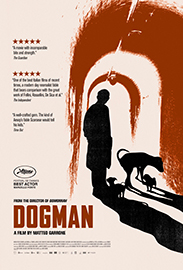As most of my readers are aware, I rarely write negative film analyses. The point of this blog is to inform followers about movies that offer inspiring examples of enlightening concepts that we can use to help ourselves in leading more fulfilling lives, particularly where the use of conscious creation/law of attraction principles is concerned. However, every so often, a picture comes along that I feel compelled to write about for reasons other than those stated above. Those instances nearly always involve releases that I find notably disturbing – or, in this case, wantonly disgusting – offerings that, to me, represent deplorable cinematic trends or genres. And that’s what brings me to “John Wick: Chapter 3 – Parabellum” (web site, trailer).
If “pornography” is truly defined in “having no redeeming social value,” then this positively awful release would most certainly qualify. The film’s simplistic, often-improbable, virtually nonexistent plot, endless fight sequences that quickly become repetitive and boring, relentlessly gratuitous violence, and monotone acting by the protagonist combine to transform what should be a compelling action thriller into a tasteless snooze that had me checking my watch more than a few times. With the exception of a few intriguing supporting performances (Angelica Huston, Laurence Fishburne, Halle Berry, Ian McShane, Lance Reddick) and the occasional infusion of humor, this one has nothing (and I do mean nothing) else to offer.
Given the perspective from which I write, I’ll admit that I look for something more meaningful than just a captivating story. I prefer offerings that have something to say while spinning a good yarn. But, contrary to some misconceptions of my work, I’m not opposed to entertaining cinema for its own sake, and that includes action-adventure sagas, such as a number of the Marvel Universe releases and the most recent installment in the “Mission Impossible” franchise, which made it onto my Top 10 list for 2018.
There’s also a misconception that, because I write about cinema from what I’ll loosely call a New Age viewpoint, I’m completely opposed to action and violence in films. That’s not true, either, a position I have explained often in my writing and radio interviews. I have no reservations about their inclusion when they’re featured in films with compelling stories and presented in context, not gratuitously. For instance, I’m a big fan of the James Bond franchise and the aforementioned “Mission Impossible” series. I delighted in the over-the-top humorously macabre “Kingsman” debut (2014) and both “Deadpool” installments (2016, 2018). I even had no problem with the excessive carnage in “Watchmen” (2009), an offering that very consciously, cleverly and intentionally used this plot device to make a point about it. In all of these cases, there was a purpose for the action and violence shown on screen, they were done so in context, and they integrally helped to make their films work. To me, that’s responsible, capable filmmaking.
However, in the latest John Wick offering, these elements are clearly out of control, going on endlessly for their own sake with an woefully weak plot to string them together. There seems to be more interest in seeing how high the body count can go without regard for telling a worthwhile story. And it lacks the humor and relevance of other pictures that employ these qualities to help reinforce their missions.
But what troubles me most is the callous, unfeeling approach that’s used here. In many sequences, the narrative consists of little more than carrying out a brutal killing and then moving on to the next in a perpetual cycle of rinse and repeat. And, to make matters worse, viewers gawk in amazement at such butchery, finding the screen action “cool.”
I find that reaction utterly appalling. I dare anyone to explain to me how such nonstop cold-blooded murder is “cool” in the slightest. Indeed, if we’re ever to see anything change in our world, we’ve got to stop glorifying such horrendous acts, even in our entertainment vehicles. As a Chicagoan who has lived through years of senseless street killings, like many of my fellow Windy City residents, I have found such acts wholly inexcusable, yet the kind of violence that’s celebrated in a movie like “John Wick” is … “cool?” Forgive me, but that kind of logic completely escapes me, even if it is “just fiction.”
In preparing this commentary, I’ve considered the viewpoints of the fans of this film. Many have contended that there was tremendous artistry and skill put into creating and filming the fight sequences, and I don’t doubt that. But what good is that if the material itself is, essentially, intrinsically pointless? Moreover, many fans have likened the picture to exquisitely choreographed martial arts classics like Bruce Lee’s “Enter the Dragon” (1973). However, despite such lofty but ultimately superficial comparisons, this offering lacks the soul of its predecessors, coming across as cold, emotionless and unconcerned for its characters and the message it’s sending to audiences.
In my view, I find myself having to agree with those few courageous dissenting critics who have, for all intents and purposes, essentially claimed that “there’s no there there”. Most of them have said that this installment plays like a video game version of the movies in this franchise, and I’d agree that they’re spot-on in their analysis. Just as video games heartlessly celebrate the deaths of their characters, so, too, does this film. And, as there seems to be some indication that some impressionable gamers may be unable to distinguish between video game kills and real life deaths, maybe filmmakers should take a lesson from that and consider what they’re putting out on the world’s movie screens. It seems to me to be the responsible thing to do.
Unless you have a penchant for watching senseless, recurring violence run amok, save your money where this one is concerned. And, if you’re like me and take issue with the message pictures like this are sending, please share this rant with others. If enough readers protest against such wantonly disgusting releases, maybe we can get the movie industry to rethink what it’s selling to the public. The #MeToo movement has already shown that such reform efforts can have an impact; maybe that result is transferable to one like this as well. The well-being of our society’s future could depend on it.
Copyright © 2019, by Brent Marchant. All rights reserved.
Friday, May 31, 2019
Wantonly Disgusting: A Film Commentary
Tuesday, May 28, 2019
Documentary Week on Movies with Meaning




Sunday, May 26, 2019
‘Ask Dr. Ruth’ lovingly profiles a sexual revolutionary
“Ask Dr. Ruth” (2019). Cast: Interviews: Dr. Ruth Westheimer, Miriam Westheimer, Joel Westheimer, Jonathan Capehart, Betty Elam. Archive Footage: Johnny Carson, Arsenio Hall, David Letterman, Joan Rivers, Diane Sawyer, Phil Donahue, Regis Philbin, Bo Jackson, Fred Westheimer, Helen Singer Kaplan. Director: Ryan White. Web site. Trailer.
Were it not for sex, none of us would be here. Yet it’s amazing how, until comparatively recently, many of us have been reluctant or embarrassed to openly discuss something so fundamental to our nature and very being. No matter what the reason behind this, the hesitant among us long avoided the subject, almost pretending as if it somehow didn’t exist. But, given the magnitude of what’s involved in sexuality – on so many different fronts – it’s often been to our detriment to evade talking about it. This is why it has been so valuable to have someone come along who has been willing and courageous enough to help lead us out of the erotic darkness, to bring sex above board and out into the open for plainspoken but informed conversation, as seen in the new biographical documentary, “Ask Dr. Ruth.”
The national discussion about sex took a dramatic leap forward in 1980 with the premiere of Sexually Speaking on New York’s WYNY-FM radio. The public affairs broadcast, which was launched primarily to fulfill the station’s FCC licensing requirements, aired Sundays at midnight, a time slot typically allocated to low-ratings programming like this. But, much to everyone’s surprise, the show became a big hit, thanks primarily to its delightfully charismatic host, sex therapist Dr. Ruth Westheimer.
The charming, diminutive Dr. Ruth had never hosted a radio show before. However, her positive demeanor, practical, no-nonsense advice, and delightful German accent captivated listening audiences. Before long, she was hosting WYNY’s most popular program. And, over the next several years, she became a national media sensation, hosting syndicated radio and TV shows and making appearances on late night talk shows, game shows and other network programs, as well as in made-for-TV movies and commercials. She almost single-handedly made it possible to speak openly, publicly and frankly about sex in the media while simultaneously transforming herself into a cottage industry that proliferated and has persisted to this day.
[caption id="attachment_10726" align="aligncenter" width="200"] At 90 years young, sex therapist Dr. Ruth Westheimer keeps a full schedule as a writer, lecturer and media celebrity, as depicted in the new biographical documentary, “Ask Dr. Ruth.” Photo by Austin Hargrave, courtesy of Hulu Originals and Magnolia Pictures.[/caption]
At 90 years young, sex therapist Dr. Ruth Westheimer keeps a full schedule as a writer, lecturer and media celebrity, as depicted in the new biographical documentary, “Ask Dr. Ruth.” Photo by Austin Hargrave, courtesy of Hulu Originals and Magnolia Pictures.[/caption]
In “Ask Dr. Ruth,” director Ryan White lovingly profiles his munchkin-esque subject, revealing how this unlikely 90-year-old sexual guru rose to prominence and made such a significant mark on the nation’s outlook on a once-taboo subject. He shows how she became a notable figure in the sex therapy arena, as well as one of the most recognizable media personalities of the past 30+ years. But what’s perhaps most interesting is the filmmaker’s depiction of how she got there, a storied journey that took her through many trials, tribulations and escapades far removed from her roots.
Born Karola Ruth Siegel to Orthodox German Jewish parents in 1928, Westheimer grew up in Frankfurt. However, with the rise of the Third Reich and antisemitism over the next decade, her family’s future became increasingly uncertain. In hopes that she would be safe, Westheimer’s parents sent her to Switzerland in 1939 as part of the Kindertransport program, an effort aimed at protecting Jewish children by housing them in orphanages. But, when the young Karola left her homeland, it was the last time she would see her parents, who would eventually become victims of the Holocaust.
When World War II ended, Westheimer emigrated to British-controlled Palestine, where she joined the Haganah, a Jewish paramilitary organization, training as a scout and sniper. She says she never killed anyone but became a sharp shooter who never missed the target. The violence in the region nearly took a toll on her in 1948, when the explosion of a shell nearly cost her both of her feet.
After nursing herself back to health, Ruth relocated to France in 1950 with her first husband, a med school student. She studied and then taught psychology at the University of Paris, the beginning of a long and impressive educational path. The marriage didn’t last, however, her husband returning to Israel. But Westheimer was not alone for long, marrying her second husband when she became pregnant with her first child, Miriam. The couple emigrated to the US in 1956 for a new beginning, but this marriage did not last, either. Ruth soon found herself a single parent in New York, seeking to make ends meet while earning her master’s in sociology from The New School for Social Research.
[caption id="attachment_10727" align="aligncenter" width="300"] Never a stranger to a microphone, sex therapist Dr. Ruth Westheimer routinely doles out advice to captivated listeners, as seen in director Ryan White’s loving tribute to the guru of eroticism, “Ask Dr. Ruth.” Photo courtesy of Hulu Originals and Magnolia Pictures.[/caption]
Never a stranger to a microphone, sex therapist Dr. Ruth Westheimer routinely doles out advice to captivated listeners, as seen in director Ryan White’s loving tribute to the guru of eroticism, “Ask Dr. Ruth.” Photo courtesy of Hulu Originals and Magnolia Pictures.[/caption]
After two failed marriages, Ruth finally found the love of her life, Fred Westheimer, whom she married in 1961. The couple became parents of a second child, Joel, in 1964, moving to an apartment in the city’s Washington Heights neighborhood, where she still lives today. Ruth worked toward her doctorate in education, a degree she earned from Columbia University in 1970.
Ruth took a job at Planned Parenthood after graduation, a position that sparked her interest in human sexuality. It served as a springboard to post-doctoral study in the subject, working as a researcher with Helen Singer Kaplan at New York-Presbyterian Hospital. This background laid the foundation for what was to come when WYNY community affairs manager Betty Elam approached Westheimer and offered her the opportunity to host Sexually Speaking. And the rest, as they say, is history.
As Westheimer’s new career developed, she became more than just the host of a show about titillating dirty talk. She was a committed sexual educator who spoke candidly about subjects rarely if ever before broached in high-profile public settings. Her advice helped to dispel myths and offer comfort and guidance to those who lived lives outside the sexual mainstream, while giving individuals of all orientations useful and imaginative ideas on how to spice up their bedroom activities. In addition to her media appearances, Ruth became an accomplished and prolific author, producing a variety of books and articles, as well as a university lecturer. She also became a staunchly vocal advocate for research during the early days of the AIDS crisis, addressing the subject head-on and professionally at a time when others downplayed it, disparaged its victims and even made fun of the devastating illness.
Through it all, Ruth truly evolved as a sexual revolutionary, unlikely though it might seem. Given the tremendous success she’s attained, it’s apparent that Westheimer is quite proficient in the practice of conscious creation, the philosophy that maintains we manifest the reality we experience through the power of our thoughts, beliefs and intents. And, even if she’s never heard of this metaphysical doctrine, it’s obvious she’s well versed in its principles. Her expertise as a therapist, author, educator, and radio and TV host is a testament to this.
[caption id="attachment_10728" align="aligncenter" width="300"] At home in New York, sex therapist Dr. Ruth Westheimer enjoys life from the same Washington Heights apartment she’s lived in for decades, one of the venues shown in the new biographical documentary, “Ask Dr. Ruth.” Photo courtesy of Hulu Originals and Magnolia Pictures.[/caption]
At home in New York, sex therapist Dr. Ruth Westheimer enjoys life from the same Washington Heights apartment she’s lived in for decades, one of the venues shown in the new biographical documentary, “Ask Dr. Ruth.” Photo courtesy of Hulu Originals and Magnolia Pictures.[/caption]
Of course, critics would contend that, if she was so adept at creating such success, then why did she endure the hardships of her youth? That’s a legitimate question, but we can never really know why others manifest what they do, since their reasons are their own, and it’s not our place to question their motives. However, surely there are purposes behind such creations, even if they’re not readily apparent.
In many instances, seemingly questionable materializations often are related to learning particular life lessons. These ordeals can be difficult to go through, but their impact can be substantial, imprinting their significance deeply within our being, perhaps alerting us to the need for not repeating them and/or learning how to avoid them again in the future.
In other cases, certain experiences can help to groom us for what is to come later in our lives. For example, Ruth’s all-too-familiar awareness of what happened to Europe’s Jewish population during World War II helped prepare her for the rampant and hostile discrimination, bigotry and intolerance inflicted upon AIDS sufferers during the early days of the epidemic. Having lived through somewhat comparable circumstances, she became quite vocal in countering the arguments of those who called for the quarantining of the sick in camps not unlike those to which Jews and other minorities were corralled as part of Hitler’s “final solution.” Had she not had that experience in her youth, she may not have been able to relate to the indignities inflicted upon AIDS patients – or to speak to the troubling proposals that were raised – as authoritatively as she did as an adult. It also enabled her to become a champion for those seeking research into the causes of, and a cure for, this debilitating and heartbreaking illness.
Then there’s Ruth’s legendary diminutive stature. Standing at a mere 4’ 7”, under most circumstances, she ordinarily might not have been perceived as a force to be reckoned with. However, her slight physique helped make her a fighter, both literally and figuratively. For instance, her limited size made her an ideal candidate for becoming a Haganah recruit, one who could easily shrink into the surroundings, a quality well suited to a scout and sniper. And that experience, in turn, helped galvanize her as a frank, outspoken advocate for her causes and subject matter. It enabled her to push through barriers and command respect for her and her work. So this naturally raises the question, would she have been able to accomplish these tasks if she had grown into a “normal” stature?
[caption id="attachment_10729" align="aligncenter" width="300"] Back in Switzerland where she escaped the Nazi encroachment during World War II, Dr. Ruth Westheimer returns to the land that provided the young German Jew sanctuary – and saved her life – during the horrors of the Holocaust, as seen in “Ask Dr. Ruth.” Photo courtesy of Hulu Originals and Magnolia Pictures.[/caption]
Back in Switzerland where she escaped the Nazi encroachment during World War II, Dr. Ruth Westheimer returns to the land that provided the young German Jew sanctuary – and saved her life – during the horrors of the Holocaust, as seen in “Ask Dr. Ruth.” Photo courtesy of Hulu Originals and Magnolia Pictures.[/caption]
This feistiness also helped to make Ruth a fierce proponent for no-nonsense sex education and advice, something that didn’t always sit well with society’s more conservative elements during the early days of her career. She met with frequent criticism, and one opponent even went so far as to try and initiate a citizen’s arrest against her for allegedly violating public morality standards. Ruth would have none of that, though, stridently maintaining her values and infusing them with hefty doses of personal integrity and informed insights, qualities essential to her effectiveness.
All of which have made it possible for Ruth to live out her value fulfillment, the conscious creation concept associated with being our best, truest selves for the betterment of ourselves and those around us. I’ve written extensively about this subject of late, but that’s been possible thanks to the array of recent film releases (mostly biographies and documentaries) that have profiled individuals and organizations whose lives and actions have embodied this principle. Perhaps their proliferation and popularity are due to a perception that this is an attribute that’s in all too short supply these days, that it’s something desperately needed in our political, social, educational and commercial institutions. Such recent movies have thus provided viewers with excellent examples to emulate, and that’s very much the case here. Ruth’s willingness to take on such a once-controversial subject as human sexuality – and to do so with obviously great joy and enthusiasm – is indicative of value fulfillment in action. We should all be so courageous and spirited in our own quests.
Westheimer’s efforts have radically changed the sexual landscape, with implications that could be far more reaching than any of us is consciously aware. Would legalized same-sex marriage, for example, have come about were it not for the changes in attitude that Dr. Ruth helped to foster? Indeed, many of us may owe her far more than we know.
This endearing tribute lovingly portrays the life and adventures of a beloved expert and educator, charming – and moving – viewers at nearly every turn. It’s gratifying to see a film that honors the work of someone who has done so much good for so many. It paints a colorful portrait of a colorful character, one that’s a sure-fire crowd pleaser. “Ask Dr. Ruth” is currently playing in a limited theatrical run and will be available for streaming on Hulu beginning June 1.
If sex is indeed an essential part of our existence, wouldn’t it make sense for us to know as much about it as we can? As a truly creative force in its own right, sex is something through which we can exercise those imagination muscles we’re all equipped with, not only to make the experience more fulfilling and enjoyable, but also to inspire our overall inventiveness and ingenuity, attributes we can employ to enrich our larger existence and not just our erotic capabilities. Thankfully, we have someone like Dr. Ruth to help launch us into such explorations of deeper awareness, understanding and satisfaction on myriad fronts. And I don’t know about you, but that’s certainly good for me.
Cigarette anyone?
Copyright © 2019, by Brent Marchant. All rights reserved.
Friday, May 24, 2019
‘Meeting Gorbachev’ celebrates a pragmatic visionary
“Meeting Gorbachev” (2019). Cast: Interviews: Mikhail Gorbachev, Werner Herzog, Miklós Németh, George Shultz, James Baker, Lech Walęsa, Horst Teltschik. Archive Footage: Raisa Gorbachev, Yuri Andropov, Leonid Brezhnev, Konstantin Chernenko, Vladimir Putin, Boris Yeltsin, Ronald Reagan, George H.W. Bush, Margaret Thatcher, Helmut Kohl, Andrei Gromyko. Directors: Werner Herzog and Andre Singer. Screenplay: Werner Herzog. Web site. Trailer.
It’s one thing to be ever-practical when it comes to conducting our affairs, but this approach may sometimes limit our options, outcomes and effectiveness. By contrast, we could adopt a truly visionary view, one that surpasses these shortcomings but that also may be difficult to fulfill due to lack of pragmatism. So it’s quite something when we’re able to fuse both qualities, making it possible to work truly inspired wonders. Such is the approach employed by an accomplished statesman, one whose achievements arguably have not received the recognition they deserve, notions addressed in the engaging new documentary, “Meeting Gorbachev.”
As the 1980s began, almost no one foresaw the significant changes that were to come over the next 10 years. However, as the decade played out, it led to an array of geopolitical shifts that carried on into subsequent years and whose impact has been felt ever since.
Nowhere was this more apparent than in the Soviet Union, a declining superpower that was being propped up largely by its own propaganda. The woeful state of the country was generally not known outside its borders, but Soviet citizens were all too aware of its shortcomings, experiencing its problems, frustrations and inadequacies on a daily basis. A string of aging and ailing leaders – Leonid Brezhnev, Yuri Andropov and Konstantin Chernenko – did little more than keep the seat warm, unable to meet the needs of a population that was tiring of perpetual shortages, rampant ineptitude and runaway corruption.
However, there was one Soviet political figure who saw the handwriting on the wall, one who knew that sweeping reform was desperately needed, one who brought a visionary pragmatism to the table and sought to see it implemented. This little-known figure seemed to come out of nowhere but quickly rose to prominence on the national and international stages, his name becoming synonymous with change in an evolving USSR, Mikhail Gorbachev.
“Meeting Gorbachev” recounts the Soviet leader’s recollections of these events. Director Werner Herzog interviews Gorbachev about his accomplishments – and disappointments – and the impact they’ve had on shaping the world of today. Intercut with these conversations are archive footage of the events themselves, as well as interviews with those who were witnesses to history, including former US Secretaries of State George Shultz and James Baker, former Hungarian Prime Minister Miklós Németh, Solidarity Founder Lech Walęsa and former West German foreign affairs advisor Horst Teltschik. This combination paints an intriguing portrait of the film’s central figure.
[caption id="attachment_10720" align="aligncenter" width="300"] Director Werner Herzog (left) interviews former Soviet leader Mikhail Gorbachev (right) in the candid new documentary, “Meeting Gorbachev.” Photo courtesy of the Tribeca Film Festival/Getty Images.[/caption]
Director Werner Herzog (left) interviews former Soviet leader Mikhail Gorbachev (right) in the candid new documentary, “Meeting Gorbachev.” Photo courtesy of the Tribeca Film Festival/Getty Images.[/caption]
From meager beginnings in rural Russia, Gorbachev grew up in the shadow of World War II and the abuses of the Stalinist regime. Life was difficult during those times, conditions that made him acutely aware of the difficulties involved in issues as basic as everyday survival. He drew upon that experience as he moved up through the ranks of the Communist Party, taking a practical approach to his official duties in such areas as agriculture and civil engineering projects.
By the late ʼ70s and early ʼ80s, Gorbachev could see that the Soviet Union was on the brink. The protracted Cold War with the West, a failed occupation of Afghanistan and simmering domestic discontent were placing an increasingly greater strain on the country, all of which could no longer be afforded. Things had to change, and, by the time Gorbachev got his shot at the top slot in 1985, he at last had his opportunity.
In the ensuing years, Gorbachev made a point to reach out to the citizenry to learn what was needed. This led to the formation of his now-famous policies of perestroika (restructuring) and glasnost (openness), doctrines that became immensely popular both at home and abroad. It helped him win over many allies and to amass considerable political capital, assets that would prove exceedingly valuable in 1986, when he faced one of his greatest leadership challenges, the nuclear accident at Chernobyl. This incident marked a turning point in both Gorbachev’s rule and in the history of the Soviet Union.
Chernobyl helped Gorbachev realize the dangers of nuclear technology, not only when it comes to power plants, but also to weapons of mass destruction. He knew that the world could not continue on the course it was on. An out-of-control arms race, he believed, was too great a risk to the future of civilization if it continued unabated. Thus began Gorbachev’s initiatives to reach out to the West, most notably President Ronald Reagan and British Prime Minister Margaret Thatcher, to bring these matters under control.
Not long thereafter, Gorbachev witnessed the rise of democracy movements in the Soviet Union’s satellite states in Eastern Europe, most notably Hungary, Poland and Czechoslovakia. He also watched the Soviet occupation of Afghanistan – a mess he inherited from his predecessors – spiral into a quagmire that was being referred to as “Russia’s Vietnam.” Realizing that he could barely manage what was happening at home, he knew that he could ill afford to take on what was happening outside his borders. These insights prompted him to handle these situations differently from his forbears, taking no action against the Eastern Bloc and withdrawing troops from his southern Islamic neighbor. Thus began a chain of events that led to the dissolution of the Warsaw Pact, the fall of the Berlin Wall and even the reunification of Germany.
Collectively, these changes brought about huge alterations in the geopolitical landscape. But, despite the progress they represented, for some, the changes didn’t unfold far or fast enough. Opportunists thus emerged to invoke their own agendas. In August 1991, a coup d’etat attempt was made to oust Gorbachev while he was vacationing with his family, but loyal supporters squelched the challenge to his authority. However, despite his success in this incident, he also faced secession initiatives launched by a number of Soviet republics, most notably the Baltic states of Lithuania, Latvia and Estonia. It wasn’t long before other republics followed suit, a move that led to the Soviet Union’s dissolution.
Once out of office, Gorbachev devoted much of his time to the establishment of a foundation, lecturing and serving as a political advisor. However, as he observes in the film, there’s a sadness associated with his later years. He’s disappointed that he was unable to complete the work he started, such as increased democratization, bridging the European Community and the Soviet Union, and continuing his work for nuclear disarmament. He’s also saddened that many of his onetime supporters abandoned him once he was no longer in power. Much of his enthusiasm was further sapped by the loss of his wife, Raisa, the love of his life, to leukemia in 1999.
Given these developments, it might be a stretch to call him “a broken man,” but the now-88-year-old has clearly been wounded by what happened to him after such a promising and auspicious start. Nevertheless, in light of how much Gorbachev accomplished, his opinion still carries weight, and we’d be wise to listen to it. He’s concerned about the current state of relations between Russia and the West, fearing the rise of a new Cold War and a new arms race. He sees this as a classic case of not learning from the past, particularly where nuclear armament is concerned. It would indeed be a tragedy if everything he worked for were to be wiped out by the shortsightedness of current leaders.
When one considers how much meaningful change Gorbachev was able to implement, one can’t help but wonder how he did it. But, in examining his means and methods, it’s apparent that he’s quite skilled in the practice of conscious creation, the philosophy that maintains we manifest the reality we experience through the power of our thoughts, beliefs and intents. Even if he’s never heard of it, his track record shows he’s certainly accomplished in its principles.
As noted above, Gorbachev is best described as a pragmatic visionary, one who’s able to picture what he wants to achieve but understands the need to reach that goal by practical means, even if he’s initially unaware of exactly what those means are. To accomplish this, he envisions what he would like the outcome to be and then actively seeks input on how to realize it. This approach is precisely how we go about forming the manifestation beliefs we need to attain our desired results. Through the process of visualizing, he draws upon his intuition to imagine the end result. And, then, by pursuing the implementing knowledge he needs to fulfill his objective, he taps into his intellect to provide the nuts-and-bolts information required to achieve that end. Thus, by drawing upon these two sources of belief input, he avails himself of the essential metaphysical tools that go into the materialization process.
To make such grand plans possible, several other conscious creation principles come into play. For instance, if change is on the menu, then tapping into our innate capacity for this is essential. This is particularly true when it comes to overcoming limitations for solving thorny problems. And, considering what Gorbachev was up against when he took office, these concepts obviously were crucial to his success.
Most importantly, though, Gorbachev’s manifestation efforts aptly reflect the principle of value fulfillment, the notion that encourages us to be our best, truest selves for the betterment of ourselves and those around us. Again, in light of what he faced when he assumed power, Gorbachev earnestly believed that he had to serve as an instrument of perestroika and glasnost if his country, his people and his planet were to survive. As conscious creators are well aware, value fulfillment can take myriad forms, but, when it’s drawn upon for goals as ambitious and noble as those Gorbachev sought, that’s truly one of the best ways this principle can be put to use. From what we’ve seen thus far, his efforts were successful; let’s hope we can hold on to what he helped bring about.
Despite a slight tendency to shortchange the first-person views of the film’s principal subject (especially where his life outside of politics is concerned), “Meeting Gorbachev” presents a thorough look at the truly remarkable accomplishments of this Soviet statesman. Some might see director Herzog’s latest as a love letter that sometimes gushes a bit much, but it also candidly sets the record straight on Gorbachev’s achievements, presenting little-known insights into historic events from both the protagonist and those who collaborated with him. This genuinely moving and inspired work is definitely worthwhile viewing, especially in light of present-day conditions.
When the fate of the world is at stake, we need to take matters seriously if we hope to survive. This means looking at our circumstances for what they really are and not what we would like them to be, no matter how difficult, daunting and disconcerting the situation may be. By adopting a realistic view, we place ourselves in a position from which we can start to work toward solutions that will help us overcome the challenges at hand. Gorbachev understood this and employed it in his endeavors – and has left us with a shining example to draw upon.
Copyright © 2019, by Brent Marchant. All rights reserved.
Tuesday, May 21, 2019
Tune in for The Cinema Scribe


Sunday, May 19, 2019
‘Hail Satan?’ charts the quest for protecting personal freedoms
“Hail Satan?” (2019). Cast: Interview Footage: Lucien Greaves, Jex Blackmore, Malcolm Jarry, Michael Wiener, Jason Rapert. Archive Footage: Megyn Kelly. Director: Penny Lane. Web site. Trailer.
Advocates for causes may sometimes be surprised where their support comes from. That’s particularly true when such unexpected backing is notably vocal and passionate. So it is for the champions of several high-profile, hot-button initiatives as seen in the snicker-filled new documentary, “Hail Satan?”
Those behind such issues as separation of church and state, women’s reproductive rights, and same-sex marriage often face an uphill battle, especially in light of the zealous, well-organized efforts of right-wing religious fundamentalists. The proponents of these measures can use all of the encouragement they can muster. But who would have thought that they would receive such support from a source like The Satanic Temple.
In “Hail Satan?”, viewers are introduced to a nontheistic “religious” minority that’s nothing like how it has traditionally been portrayed. Through the mainstream media, Hollywood movies and other sources, Satanists have been depicted as evil incarnate hell-bent on engaging in all sorts of horrendous, unnatural, unspeakable acts. Yet, as director Penny Lane’s documentary reveals, these characterizations are largely juvenile exaggerations, the product of a well-orchestrated smear campaign to distort who they really are and what they’re seeking to achieve.
Members of the Temple freely acknowledge themselves as followers of “the opposition.” But this is not meant so much to be opposition to God as much as it is meant to be opposition to those who contend to authoritatively and exclusively speak for the Divine. In that vein, that would include those who intolerantly proclaim their religions to be the sole, unquestionable truth that everyone must follow to the exclusion of all other faiths, schools of theological thought that they dismissively regarded as nothing more than outright heresy. These are notions primarily put forth by fundamentalist Christians, who look upon other religions with disdain and contempt (and, if they feel that way about mainstream creeds, one can only imagine what they have to say about Satanists).
[caption id="attachment_10709" align="aligncenter" width="300"] Protestors rally against members of The Satanic Temple seeking to promote religious pluralism as seen in the tongue-in-cheek new documentary, “Hail Satan?” Photo courtesy of Magnolia Pictures.[/caption]
Protestors rally against members of The Satanic Temple seeking to promote religious pluralism as seen in the tongue-in-cheek new documentary, “Hail Satan?” Photo courtesy of Magnolia Pictures.[/caption]
Temple members, by contrast, maintain that we should all be free to follow whatever faith best suits us, be it Christianity, Judaism, Buddhism, Hinduism or, in their view, Satanism. They believe their mission is to help preserve that right – for everyone – and to steadfastly challenge anyone who would try to take it away. This belief in religious pluralism, they insist, is essential to a society, such as ours, that claims to revere the formal separation of church and state.
In recent years, however, this principle has come under fire, especially when fundamental Christians have undertaken such initiatives as trying to erect Ten Commandments monuments on the grounds of capitol buildings in states like Oklahoma and Arkansas. Members of The Satanic Temple have countered by contending that, if states allow Christian monuments to be placed on public properties, they must also allow the erection of comparable testaments to other religions on those same grounds. To that end, then, Satanists have sought to have statues of their goat-headed god Baphomet installed alongside whatever Christian monuments might be placed on those properties. After all, in a supposedly secular state, fair is fair, they say.
“Hail Satan?” chronicles these efforts, depicting how these outspoken, left-leaning activists have taken on their sanctimonious counterparts and effectively made them look like ridiculous religious blowhards. Instead of patently malevolent deeds, viewers are shown the cleverly crafted campaigns of this band of comically sinister but basically harmless bogeymen gleefully poking holes in the dogma of the religious right. Like impish frat boys pulling pranks, this amusingly macabre contingent of nonconformists has succeeded in capturing public and media attention, deftly outwitting its opposition at virtually every turn.
[caption id="attachment_10710" align="aligncenter" width="300"] Satanic Temple co-founder Lucien Greaves (standing at podium) speaks to a crowd of supporters seeking to erect a statue of the goat-headed god Baphomet on the grounds of the Arkansas State Capitol building in director Penny Lane’s “Hail Satan?” Photo courtesy of Magnolia Pictures.[/caption]
Satanic Temple co-founder Lucien Greaves (standing at podium) speaks to a crowd of supporters seeking to erect a statue of the goat-headed god Baphomet on the grounds of the Arkansas State Capitol building in director Penny Lane’s “Hail Satan?” Photo courtesy of Magnolia Pictures.[/caption]
According to Satanic Temple co-founder Lucien Greaves, efforts like the ones his organization are pursuing are crucial to preserve the sweeping freedoms set down in the U.S. Constitution and to prevent their hijacking by those with their own narrow agendas. Speaking from the Temple’s headquarters in Salem, Massachusetts, where a number of innocent women were wrongly put to death for their views in the witch trials of the 1690s, Greaves and his followers believe these efforts need to start with setting the record straight about America’s innate secular nature and religiously neutral legacy. They’re particularly concerned about dispelling the fallacy that the U.S. is a historically “Christian nation.” Indeed, viewers may well be surprised to learn how the promotion of this widely held myth began as a Cold War propaganda ploy to counter the overblown and supposedly insidious spread of “Godless Communism” throughout the land. And, in that regard, audiences will likely be tickled (or possibly shocked) at discovering how the campaign to get Ten Commandments monuments erected on the nation’s municipal properties actually got its start.
However, separation of church and state is but one of the Satanists’ aims. As the film shows, they have also taken on such other faith-based issues as the hypocrisy of religious institutions, most notably the Roman Catholic Church and its cover-up of the actions of pedophile priests (something one won’t find among the ranks of the leaders of The Satanic Temple, they contend). In addition, they have railed against initiatives to institute prayer in school and at government meetings (unless, of course, Satanic verses can be included as part of those programs as well). They have even sought the establishment of after-school Satanic groups in locales where Christians have actively sought to launch Bible studies.
[caption id="attachment_10711" align="aligncenter" width="287"] To counter the launching of after-school Bible study groups, Satanic Temple members have sought to establish comparable groups promoting their “religion,” as depicted in director Penny Lane’s snicker-laden documentary, “Hail Satan?” Photo courtesy of Magnolia Pictures.[/caption]
To counter the launching of after-school Bible study groups, Satanic Temple members have sought to establish comparable groups promoting their “religion,” as depicted in director Penny Lane’s snicker-laden documentary, “Hail Satan?” Photo courtesy of Magnolia Pictures.[/caption]
On a more secular level, Satanists have sought to preserve women’s reproductive protections and to promote gay rights, most notably same-sex marriage. Much of the opposition in these areas also comes from religious organizations, such as the insufferably vocal, supremely homophobic Westboro Baptist Church, which the Temple has unabashedly taken on publicly with devilish glee. The measures implemented by Temple members to counter such protests have been just as satirical, thought-provoking and creative as those used in their other endeavors, all designed to raise awareness about the corruption, hypocrisy and self-serving agendas behind these dubious, reactionary initiatives.
Without a doubt, Satanists have been called “dangerous” for what they do. Yet, if this film is any indication, perhaps the most seditious idea they’re calling for is to think for ourselves. And, if that is indeed a vile, distasteful notion, then perhaps it’s high time for any of us with any common sense to consider moving out of the country. But not if the Satanists have their say; they plan to hold their ground. And, because their ideas seem to speak to a broad number of people, they have become one of the fastest growing religious sects in the country today.
Of course, calling The Satanic Temple a religion may be a bit of a stretch. Most of these ideas are fundamentally social and political in nature, though, for tax purposes, the Temple has had itself legally classified as a religion, something more conventional faiths would probably rail against (even though they often do the same themselves). But this is more proof that Greaves and company can beat the others at their own game and get away with it.
From viewing this film, it would seem that much of what we’ve been taught to believe about Satanists is unfounded, that they’re misunderstood and innocent of what they’ve been accused. The Temple has even taken steps to cultivate this image by issuing guidelines to its various chapters outlining what the faith stands for, an attempt to promote consistency and continuity among its members and leaders in educating the public.
However, as often happens with religious organizations, there are those within them who invariably go rogue, deviating from the institution’s doctrines and principles, and The Satanic Temple is no exception. The documentary reveals this through the Temple’s official severance of ties with its Detroit chapter, led by overzealous advocate Jex Blackmore. She believed that progress for the Satanist agenda was coming too slowly and began advocating actions, such as violence, to speed up the process. Given this violation of the Temple’s tenets, Greaves cut off relations with this chapter, calling it a regrettable but necessary action to preserve the Temple’s image and prevent the public from getting the wrong impression. In that regard, then, it would seem that even Satanists are not immune to the administrative problems that can hamper the missions of religious institutions.
[caption id="attachment_10712" align="aligncenter" width="300"] Followers of The Satanic Temple gather on the grounds of the Arkansas State Capitol building in Little Rock seeking the erection of a statue of Baphomet in response to the placing of a Ten Commandments monument in an attempt to promote religious pluralism, as seen in “Hail Satan?” Photo courtesy of Magnolia Pictures.[/caption]
Followers of The Satanic Temple gather on the grounds of the Arkansas State Capitol building in Little Rock seeking the erection of a statue of Baphomet in response to the placing of a Ten Commandments monument in an attempt to promote religious pluralism, as seen in “Hail Satan?” Photo courtesy of Magnolia Pictures.[/caption]
Nevertheless, despite such issues, it would seem the Temple is doing something right to spur its impressive growth. When organizations like this experience such an expansion in a short period of time, they’re usually espousing ideas that have widespread appeal for a large pool of would-be followers. So, in light of the corrupt, hypocritical state of affairs characterizing many segments of contemporary society, as well as the growing number of individuals who are becoming increasingly intolerant of such conditions, it shouldn’t come as any surprise that the ideas championed by an institution openly opposed to such circumstances would attract the backing of a number of fiercely loyal, dedicated followers.
At bottom, the success behind organizations like this is ultimately driven by the implementation of the beliefs they advocate, and that’s crucial for their growth and popularity, because those notions underlie the origin and sustained materialization of such institutions. That means of manifestation is at the core of the conscious creation process, the philosophy that maintains we realize the existence we experience through the power of our thoughts, beliefs and intents. And, considering the intense passion driving the ideology of The Satanic Temple and the fervor of its members, it’s no wonder that the organization has proliferated as it has.
The Temple’s beliefs have obviously struck a chord with many individuals looking for answers to a litany of social ills that conventional religious and secular institutions either, at best, have been unable to provide or, at worst, have directly caused themselves. Satanism has provided a mechanism through which they can channel their energies, enabling them to push through the limitations that hold them back (and, they would hope, to eradicate the ignorance that binds and blinds the majority of society at large). And, through their inspired attention-grabbing ventures, they seem to be getting some results. Indeed, the opposition has arrived.
In considering the foregoing, some might say they have come up with some novel ways of making valid points. Others, by contrast, might easily call them the latest iteration of the silver-tongued con man. But, when looking at the holier-than-thou spokespersons who definitively claim to speak for the Divine and comparing their supposedly unquestionable evangelizing with their often-questionable public and private acts, one quite legitimately has to wonder who the real charlatans are. (After all, weren’t we warned about false prophets?)
This is not to suggest that everyone should scurry out and join the ranks of the Satanists; that’s a highly personal, individual decision. However, in reading the Temple’s seven basic tenets (see below), one finds principles that are hard to take issue with. If those who lead today’s mainstream religions were to earnestly embrace even half of these notions, the world would be a much better place for it. Let’s hope this film helps to set the record straight about these concepts and those who adhere to them, regardless of whether or not one subsequently opts to become a card-carrying member.
This tongue-in-cheek but thought-provoking look at the efforts of committed but misunderstood activists battling duplicitous religious and political institutions with agendas more dangerous than anything they’re proposing gives us all much to ponder. Amidst the many laughs are telling truths that we should all take seriously if we hope to protect the freedoms we have so diligently sought to carve out for ourselves. Anyone who identifies with the maligned outcasts of society will no doubt relate to the Satanists’ message and realize who it is we should really be afraid of. In relating this story, “Hail Satan?” received a well-earned Sundance Film Festival Documentary Grand Jury Prize nomination.
Recent events have shown us that our rights have fallen into an increasingly precarious position, making their protection ever more important. The need for diligence, even with the backing of unlikely supporters, is crucial to preserve them. Indeed, thinking for ourselves shouldn’t be seen as an unnatural state of affairs but as a wholly mainstream concept that we all enthusiastically embrace – no matter who advocates it.
The Seven Tenets of The Satanic Temple
- One should strive to act with compassion and empathy towards all creatures in accordance with reason.
- The struggle for justice is an ongoing and necessary pursuit that should prevail over laws and institutions.
- One’s body is inviolable, subject to one’s own will alone.
- The freedoms of others should be respected, including the freedom to offend. To willfully and unjustly encroach upon the freedoms of another is to forgo your own.
- Beliefs should conform to our best scientific understanding of the world. We should take care never to distort scientific facts to fit our beliefs.
- People are fallible. If we make a mistake, we should do our best to rectify it and resolve any harm that may have been caused.
- Every tenet is a guiding principle designed to inspire nobility in action and thought. The spirit of compassion, wisdom, and justice should always prevail over the written or spoken word.
Copyright © 2019, by Brent Marchant. All rights reserved.
Thursday, May 9, 2019
This Week in Movies with Meaning




‘On Her Shoulders’ speaks for those without a voice
“On Her Shoulders” (2018). Cast: Nadia Murad, Murad Ismael, Amal Clooney, Borys Wrzesnewskj, Michelle Rempel, Barack Obama, Ki-moon Ban, Simone Monasebian, Ahmed Khudida Burjus. Director: Alexandria Bombach. Screenplay/Translation: Hishyar Abid, Nawaf Ashur, Deniz Ekici, Yousif Haskan and Shahnaz Osso. Web site. Trailer.
For those without a voice, it’s often difficult to be heard. In those cases, it generally takes someone with the courage and resilience to step up and make the case for them, not the easiest of undertakings. But, when an advocate with the right qualities emerges, incredible results are possible. So it is with an unlikely envoy for a little-known aggrieved people as seen in the stirring documentary, “On Her Shoulders,” available on DVD, Blu-ray Disc and video on demand.
Speaking for refugees whose story has largely gone ignored is difficult enough, but, when the spokesperson is one of those refugees herself, the burden can be a lot to carry. So it has been for Nadia Murad, a passionate advocate for the Yazidi people of northern Iraq, a religious and ethnic minority whose homeland was overrun by attacking ISIS forces in 2014. Through an orchestrated campaign of carnage that included murder, rape and sexual enslavement, the insurgents quickly overran their victims, including a 19-year-old Nadia, who was held captive for three months before escaping. Her ordeal became her cause, which is now told in director Alexandria Bombach’s documentary.
[caption id="attachment_10699" align="aligncenter" width="300"] Former ISIS captive Nadia Murad details her painful experiences and those of her fellow Yazidis in the moving documentary, “On Her Shoulders,” available on DVD, Blu-ray Disc and video on demand. Photo courtesy of Oscilloscope Laboratories.[/caption]
Former ISIS captive Nadia Murad details her painful experiences and those of her fellow Yazidis in the moving documentary, “On Her Shoulders,” available on DVD, Blu-ray Disc and video on demand. Photo courtesy of Oscilloscope Laboratories.[/caption]
The film follows Murad as she seeks to make the story of her people known to a world that has heard precious little about them and their plight through mainstream media channels and official sources. Through visits to Canada, Germany and Greece, the film documents Nadia’s efforts to inform the public through interviews, personal appearances, and meetings with both refugees and political figures. In addition to increasing awareness about this humanitarian crisis and seeking the attention and support of the United Nations, Nadia’s work also includes tireless efforts to bring war crimes charges against the culprits who plundered her community, an initiative backed by human rights attorney Amal Clooney.
But “On Her Shoulders” is more than just a record of Nadia’s official activities. It also depicts the phenomenal pressure that has been unexpectedly thrust onto a young woman who wanted nothing more than to live a simple life in her homeland. This becomes apparent through her nonstop schedule of events to spread the word and to comfort those who were fortunate enough to flee the tyranny of their attackers. It’s also painfully obvious through the media interviews and hearing testimony that she gives in which she recounts in painful detail – over and over again – the ordeals that she and her people suffered at the hands of her enemies. The film thus reveals an individual of remarkable personal strength and fortitude, as well as a committed and eloquent spokesperson for an oppressed community.
Needless to say, all of this has carried a tremendous cost, both at the time of Nadia’s capture and torture, as well as in her constant reliving of the ordeal in making the case for her people. However, given what’s at stake, she refuses to capitulate to these circumstances, continually striving to promote awareness of the genocide and atrocities inflicted on the Yazidis. This is perhaps best reflected during her address before the U.N. General Assembly in 2016, when she stated, “This world was not only created for you and your families. We also want life, and it’s our right to live it. If beheading, taking women as sex slaves, raping children and the displacement of millions will not move you – when will you move?”
[caption id="attachment_10700" align="aligncenter" width="300"] With Yazidi activist Murad Ismael (second from right), former ISIS captive Nadia Murad (left) addresses a crowd in Germany in director Alexandria Bombach’s affecting documentary, “On Her Shoulders.” Photo courtesy of Oscilloscope Laboratories.[/caption]
With Yazidi activist Murad Ismael (second from right), former ISIS captive Nadia Murad (left) addresses a crowd in Germany in director Alexandria Bombach’s affecting documentary, “On Her Shoulders.” Photo courtesy of Oscilloscope Laboratories.[/caption]
Based on the foregoing, it’s easy to see how this unlikely champion of her cause is an embodiment of courage and inspiration. She’s firmly rooted in her convictions, convinced that she must carry through and fulfill her mission. These traits and ambitions are clearly indicative of someone well versed in the practice of conscious creation, the philosophy that maintains we manifest the reality we experience through the power of our thoughts, beliefs and intents. And, regardless of whether or not she’s consciously aware of the existence of this discipline, her actions and efforts nevertheless faithfully reflect its principles.
This is particularly true when it comes to the concept of value fulfillment, the principle that maintains we live out our beliefs to be our best, truest selves for the betterment of ourselves and those around us. Given what Nadia has undertaken, it’s hard to imagine someone more devoted to justice and the well-being of her people. Despite the tremendous personal pain she has suffered, she has carried forward fearlessly with an unshakable faith in her convictions, determined to see things through. We should all be so committed to our endeavors.
Thanks to her efforts, word of the plight of the Yazidis has finally begun to gain recognition. This remarkable young woman should be commended for everything she has accomplished thus far. Let us hope that we don’t let her down now that she’s made her case and gotten our attention.
[caption id="attachment_10701" align="aligncenter" width="300"] Speaking to Yazidi refugees in Greece, Nadia Murad (second from right), spokesperson for her displaced people, learns of the experiences of her peers in the stirring documentary “On Her Shoulders,” available on DVD, Blu-ray Disc and video on demand. Photo courtesy of Oscilloscope Laboratories.[/caption]
Speaking to Yazidi refugees in Greece, Nadia Murad (second from right), spokesperson for her displaced people, learns of the experiences of her peers in the stirring documentary “On Her Shoulders,” available on DVD, Blu-ray Disc and video on demand. Photo courtesy of Oscilloscope Laboratories.[/caption]
This incredibly moving documentary can be a difficult film to watch at times, but its impact is undeniable. One can’t help but feel for the fate of the Yazidis, as well as Nadia’s personal pain, accomplishments attained through Bombach’s masterful direction. The filmmaker genuinely earns our heartfelt emotions without becoming manipulative, maudlin or gratuitously graphic. “On Her Shoulders” is authentically affecting in a way that many other films telling similar stories fail to achieve.
For its efforts, the film received a number of honors and awards, most notably the National Board of Review’s prestigious Freedom of Expression Award. In addition, the picture earned two Independent Spirit Award nominations, including nods for best documentary and the competition’s Truer Than Fiction Award. It also picked up two Sundance Film Festival documentary nominations for best director and the Grand Jury Prize.
It’s truly unfortunate in this day and age that we still need advocates like Nadia Murad. But, as long as we as a species continue to engage in the kinds of atrocities like those committed against the Yazidis, the stories of these horrendous crimes must be told. Thankfully, we’re fortunate to have courageous souls who are unafraid to speak up and make the truth known in hopes that we can keep such horrific episodes from happening again.
Copyright © 2019, by Brent Marchant. All rights reserved.
Tuesday, May 7, 2019
‘Dogman’ unleashes one’s wont of personal power
“Dogman” (2018 production, 2019 release). Cast: Marcello Fonte, Edoardo Pesce, Nunzia Schiano, Adamo Dionisi, Alida Baldari Calabria, Laura Pizzirani, Aniello Arena. Director: Matteo Garrone. Screenplay: Ugo Chiti, Matteo Garrone, Massimo Gaudioso, Marco Perfetti, Giulio Troli and Fratelli D’Innocenzo. Story: Ugo Chiti, Matteo Garrone and Massimo Gaudioso. Web site. Trailer.
Few among us would deny the attraction we feel for a sense of personal power. It enables us to direct our destiny and shape the existence we want for ourselves. But it also comes with a temptation, one that can easily get out of hand if left unchecked. And it carries consequences, especially if we misuse it in our dealings with others or our community. It’s an issue that the residents of a neighborhood past its prime wrestle with every day in the tense new dramatic release, “Dogman.”
Life in a rundown Italian seaside community has its residents on the edge, thanks to the relentless crimes, bullying and intimidation of Simoncino (Edoardo Pesce), a former boxer with anger management issues and a serious cocaine habit. He does as he pleases, trashing property, burglarizing homes and businesses, and beating up the vulnerable, including his own mother (Nunzia Schiano), whenever he feels like it. The locals fear him, but they also believe that something has to be done about him, given that authorities do nothing to stop him. It’s like living on the American frontier in the 19th Century, a story that brings new meaning to the term “spaghetti Western.”
It doesn’t help matters that Simoncino has enablers who let him get away with what he wants. Whether they act out of self-preservation or the promise of rewards for their assistance, his shady colleagues quietly help him out when the need calls, often despite publicly condemning his actions. That’s most true of a kindly but weak-willed dog groomer, Marcello (Marcello Fonte), whose conciliatory gestures are mostly intended to keep Simoncino from unduly picking on him. Sometimes Simoncino throws a bone to his coerced cohort, but it’s often paltry and usually less than promised.
[caption id="attachment_10692" align="aligncenter" width="300"] Marcello (Marcello Fonte), a sensitive but weak-willed dog groomer in a rundown Italian seaside community, does his best to carve out a living while fending off the neighborhood bully in the tense new dramatic release, “Dogman.” Photo courtesy of Magnolia Pictures.[/caption]
Marcello (Marcello Fonte), a sensitive but weak-willed dog groomer in a rundown Italian seaside community, does his best to carve out a living while fending off the neighborhood bully in the tense new dramatic release, “Dogman.” Photo courtesy of Magnolia Pictures.[/caption]
Marcello’s willingness to help Simoncino seems puzzlingly out of character. Given how he dotes on his canine clients and lovingly cares for his young daughter, Alida (Alida Baldari Calabria), his readiness to go along with the bully’s schemes come across as wholly anomalous. At times Marcello’s actions appear aimed at quelling the tension. Sometimes they’re efforts to save his own neck. And occasionally he sees opportunities to potentially get something out of these schemes. But, most of the time, his involvement is inexplicable. One can’t help but wonder what he’s thinking.
As time passes, Simoncino’s offenses grow increasingly unpredictable and ever more despicable. Meanwhile, Marcello’s responses become progressively more desperate and humiliating. He even takes the rap for crimes he didn’t commit. And, as all of this plays out, the neighbors are losing their patience with the entire situation. But what can be done? Marcello’s faced with quite the dilemma, but he knows a resolution is desperately needed – and soon.
As much as Simoncino looks to profit materially from his antics, he’s obviously most concerned with the acquisition of power and control over his neighbors and community. He actively asserts himself to amass these commodities, while those around him (particularly Marcello) routinely and willingly hand them over. Understanding that dynamic is thus crucial to appreciate why each of these characters experiences life as they do.
[caption id="attachment_10693" align="aligncenter" width="300"] Simoncino (Edoardo Pesce, left), the neighborhood bully in a rundown Italian seaside community, intimidates Marcello (Marcello Fonte, right), a sensitive but weak-willed dog groomer, to get his way in director Matteo Garrone’s latest offering, “Dogman.” Photo courtesy of Magnolia Pictures.[/caption]
Simoncino (Edoardo Pesce, left), the neighborhood bully in a rundown Italian seaside community, intimidates Marcello (Marcello Fonte, right), a sensitive but weak-willed dog groomer, to get his way in director Matteo Garrone’s latest offering, “Dogman.” Photo courtesy of Magnolia Pictures.[/caption]
Simoncino succeeds in his efforts because he believes he can get away with them. He envisions what he wants and then makes sure he acquires or develops the means to get it, all of which are products of his thoughts, beliefs and intents. These are the cornerstones of the conscious creation process, the philosophy that maintains we employ these manifesting tools in materializing the reality we experience. The neighborhood bully understands and makes use of the power behind these metaphysical building blocks all too well, even if he’s unaware of the existence of this process or what it’s called.
By contrast, Marcello and the others in his neighborhood cower in fear, believing there’s nothing that can be done about the local nemesis. In embracing that belief, they create a reality based on that notion; they give their power away, leaving them with nothing to defend themselves against someone who wields it so effectively. Thus it should come as no surprise why they’re subjected to such intolerable conditions.
With such circumstances in place, one might think that all is lost, that remediation is impossible. But, given that conscious creation makes any conceivable option attainable, futility need not be inevitable; change is indeed possible. However, it requires an alteration to the manifesting beliefs that are creating these conditions in the first place. Nevertheless, as long as the prevailing thinking is allowed to hold sway, nothing will change; new beliefs must be formulated and implemented to make that happen.
Of course, it takes more than just new beliefs; they must be followed up with action. That means beliefs must be put into place envisioning both the nature of the sought-after change and how it’s to be achieved. For much of the film, that latter consideration seems to be the stumbling block to seeing new possibilities realized. If area residents really want something different for themselves, they must devise plans that get results and go beyond mere wishful thinking.
[caption id="attachment_10694" align="aligncenter" width="300"] Marcello Fonte gives an award-winning performance as a sensitive but weak-willed dog groomer in a rundown Italian seaside community in the tense new dramatic release, “Dogman.” Photo courtesy of Magnolia Pictures.[/caption]
Marcello Fonte gives an award-winning performance as a sensitive but weak-willed dog groomer in a rundown Italian seaside community in the tense new dramatic release, “Dogman.” Photo courtesy of Magnolia Pictures.[/caption]
This is where power again comes into play. Marcello and his neighbors must insist on taking it back and putting it to use to attain what they want. The question in this, of course, is, do they possess the personal fortitude to see this through? That means ditching any fear-based beliefs that they cling to, embracing the courage necessary to implement plans for change (and, in this case, change that’s inherently radical, far different from the circumstances to which they’ve grown accustomed).
For the results to be truly meaningful, they must also consider how personal integrity factors into the mix, for it will have tremendous impact on the nature and quality of the results. In Marcello’s case, for example, he’s a sensitive, thoughtful, caring individual, so, if he’s to come up with a plan that sincerely satisfies him, he needs to figure out how he can achieve results without violating his own code of personal conduct. However, that may prove to be a tall order under the circumstances.
Can Marcello indeed make that happen? That remains to be seen. It’s something that will require quite a feat of creativity, one that employs options that may not have been previously contemplated, surpassing the limitations of easy answers that could be construed as personal compromises. Should he resort to convenient fallbacks, he could well end up disappointed with the outcome, one that’s not in line with his standards, disappointingly demonstrating that he’s no better than the foe he’s attempting to vanquish. It’s something we must all heed when faced with situations like this, for the results might easily expose who the real “dogman” is in these circumstances.
I must confess to having a love-hate relationship with this offering. While the film presents an interesting premise that’s well constructed during the first two acts, it seems to paint itself into a corner as it heads toward the conclusion, not quite sure how to wrap up the story. To avoid losing the essence of its central message, the picture regrettably resorts to predictable, conventional means to accomplish this goal, creating something of a letdown in light of the originality depicted at the outset. Sensitive viewers should also be aware that the film features some violent and disturbing sequences. They never get gratuitously out of hand and are generally presented in context, but they’re far from tame, and those who are easily upset by such images should bear this in mind. “Dogman” has been featured at many film festivals and is currently playing in limited release in theaters specializing in independent and foreign film.
Despite its shortcomings, “Dogman” has received its share of accolades. At the 2018 Cannes Film Festival, director Matteo Garrone’s latest earned Fonte the best actor award for his portrayal of the timid dog groomer, a role in which he comes across like an edgy version of a young Jerry Lewis. In addition, the film captured the Festival’s Palm Dog Award in recognition of its outstanding canine cast, as well as a nomination for the Palme d’Or, the event’s highest honor. What’s more, at the BAFTA Awards, the picture picked up a nomination for best foreign language film.
An old adage maintains that “absolute power corrupts absolutely.” Based on the story presented here, it’s easy to see how that can happen, too. But personal power need not become a runaway carriage; it can be tempered and focused into productive pursuits, provided that we make the effort to funnel our beliefs in that direction. And, if we should get off on the wrong path, it’s something we earnestly should consider doing before our lives go to the dogs.
Copyright © 2019, by Brent Marchant. All rights reserved.
Monday, May 6, 2019
Catch The Cinema Scribe


Symbolism in Cinema




